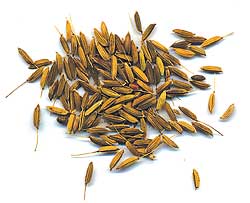 Most Nepalis do not need to set aside a year to 'celebrate' the importance of rice-it's already their staple diet. Indeed, rice is the main food for more than half of humanity. Archaeological evidence from central Thailand shows that human beings have cultivated rice for the past 6,000 years.
Most Nepalis do not need to set aside a year to 'celebrate' the importance of rice-it's already their staple diet. Indeed, rice is the main food for more than half of humanity. Archaeological evidence from central Thailand shows that human beings have cultivated rice for the past 6,000 years. In Nepal, rice fields make up 325,000 hectares, accounting for most of the country's total cultivated land area. Nepal's Jumli marshi dhan is a cold tolerant variety that is the world's highest-growing rice-cultivated at altitudes of nearly 3,000 metres.
We will hear a lot about rice in 2004. But for us in Nepal it is important to look at the places from where this resource was taken and locally developed by farmers over centuries. The last of our wild wetlands still hosts this diversity. Wild rice species occur in the Himalayan foothills, Asian river deltas, Caribbean islands, Amazon River basin and inland swamplands of southern and western Africa. Although rice is found mostly in tropical areas, the existence of one species (Oryza rufipogon) in Pokhara and surrounding the Bulbule Lake area of Surkhet is the highest latitude of wild rice growth reported in the world.
In Nepal, various species of wild rice are found in the plains, the Pokhara valley, Kamalpokhari in Palpa, Bulbule lake area in Surkhet, Kapilvastu, Nepalganj, the Lothar forest of Chitwan, the Kankai Irrigation Headwork area of Jhapa, the Sundarpur Agricultural Farm area of Kanchanpur and Nijgadh in Bara. Many of these wetland sites, important habitats of wild rice, are being degraded because of encroachment for conversion into rice fields, fishponds, extended settlements and sedimentation.
Although local communities use wild rice during religious and cultural occasions, they are not fully aware of the value of these wetland genetic resources and often consider it a weed. Government policy has also not given enough importance to the conservation of wild rice, and these habitats may soon be lost forever.
Nepal has four species of wild rice of which one is an upland species and the others are mostly found in tarai wetlands. A weedy wild rice sometimes occurs in tarai wetlands mixed with cultivated rice. The wild relatives of rice grown are important because they contain the original genetic material of cultivated rice. Although it is fit for human consumption, it is not cultivated because harvesting is tedious. Wild rice is usually harvested for cattle feed.
Every year from October-December, the people around Ajingara Lake in Kapilbastu tie cloth and plastic bags on wild rice plants to collect their seeds called tinna/tinni rice that are eaten during the Chhat festival and fasts like ekadashi. In the Lumbini area, wild rice (O rufipogon) has been culturally associated with the tarai ethnic communities.
In Nepal, farmers have developed and grown more than 95 local aromatic and fine rice varieties. Kaski district alone used to have more than 75 local varieties. Today only 11 varieties are widely grown. The remaining are being replaced or discontinued because of modern, higher yielding 'improved' seeds. Farmers in Kosi Tappu Wildlife Reserve used to cultivate multiple varieties of rice to reduce crop depredation and damage from wild animals. These varieties have now been replaced with modern ones.
Despite the potential of wild rice, little has been done to study its significant traits and breeding habits. The government seems more interested in importing new modern hybrid seeds than conserving native wild rice species.
To protect Nepal's wild rice and its genetic resource for posterity, we need to protect our wetlands where they grow.
(Sameer Karki)


